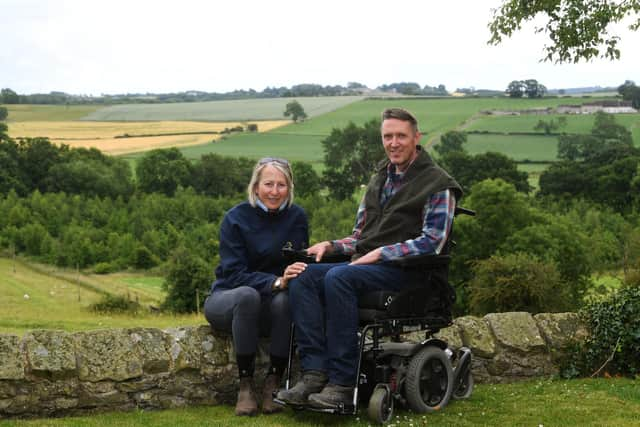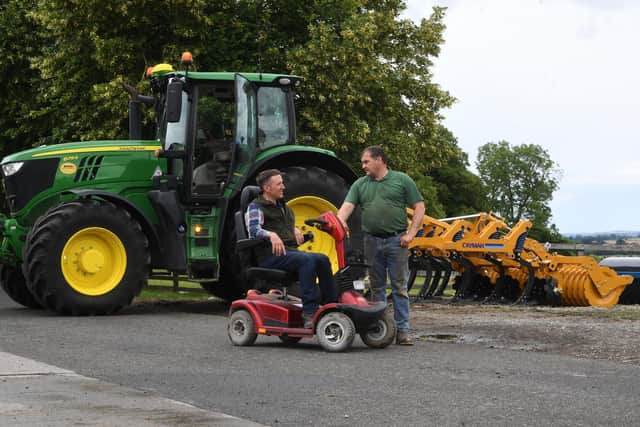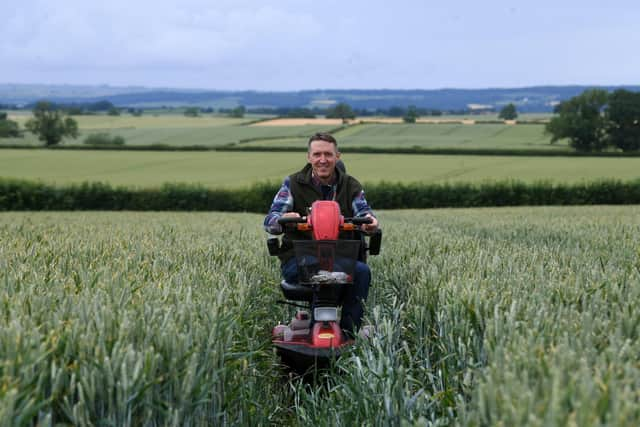Farm of the Week: Meet the arable farmer with multiple sclerosis who is dedicated to improving soil health
Philip Metcalfe is the fourth generation to farm at Foxberry Farm, Caldwell, north of the A66 but south of the River Tees. Philip took over the reins from his father Colin in 2000 and has now run the 472-acre farm for over 20 years adding his own stamp.
Philip said he has always seen soil management as his first priority.
Advertisement
Hide AdAdvertisement
Hide Ad“Soil is our biggest asset and we’ve got to look after it. Over the last twenty-plus years we have been trying to increase organic matter levels and we have been successful in doing it.


“We are on minimal tillage, non-inversion, and we are now looking at no till. I’ve a drill coming to conduct some trial work for our next seeding time. It’s an Italian drill from Ma/Ag who are specialists in minimal and no tillage equipment.
“A number of years ago I read somewhere that arable soils only had probably 50 years left in them if we carried on abusing them and so I’ve been adding organic matter all the time to try and extend the soil’s life and leave it in a better state.”
Philip said that minimal tillage certainly has not been a hindrance to his crops’ yields.


Advertisement
Hide AdAdvertisement
Hide Ad“Over the past seven years we’ve had our highs and lows but we have achieved a respectable 3.79 tonnes per acre to 4.65 tonnes on what is predominantly sandy clay loam over limestone and on what is fringe land between hill and lowland of around 350ft above sea level.
“It is still the weather that has more effect than anything. You need a good establishment period and a good growing season. They are still the main determinators, along with a bit of intervention from me.
“Our crop rotation is winter barley, oilseed rape, winter wheat, winter beans, winter wheat, with either spring barley or grass or potatoes in the sixth or seventh years.
“This year we have 150 acres of winter wheat of which the majority is the variety Gleam, with around 27 acres down to the seed varieties Champion and Palladium as part of an agreement we have with a local seed producer just five miles away.”


Advertisement
Hide AdAdvertisement
Hide AdPhilip said he doesn’t suffer from blackgrass and that his increase in break crops has given him greater opportunity to grow other varieties and other crops.
“Oilseed rape is another main crop for us and the neonicotinoids ban has been an issue we’ve had to manage. It’s about looking at the crop daily and my wife Sara says I’m obsessed about it to the point that you might as well call me Mr Slug at certain times of the year.
“It’s just that once a slug or flea beetle has been on it the crop is gone, so you have to be on it, to be vigilant, to prevent it.
“We have 70 acres of oilseed rape this year, along with 35 acres of winter barley variety Bolton and 60 acres of spring barley variety Prospect. It’s all feed barley.”
Advertisement
Hide AdAdvertisement
Hide AdWinter beans make up 32 acres of this year’s cropping with around 22 acres rented out to neighbouring growers. Philip said that’s as much as they have given over to potatoes in one year and that he has a new crop in conjunction with a neighbouring farmer.
Cover crops play their part in Philip’s cropping mix and he said they are also part of his involvement with the Countryside Stewardship scheme although he admits to being baffled by legislation at times, which has worked against what he feels is the right thing to do.
“We were in Entry Level Stewardship and now we are in Countryside Stewardship. As such we have a mix of cover crops including oil radish, black oats, phacelia, vetch and clover. We have been putting in cover crops for the past five years.
“Last year we would have liked to put more cover crops in but we couldn’t because we were in the Countryside Stewardship scheme for over wintered stubble and you can’t put a cover crop in if you’ve signed up to the overwintered stubble. It was a bit crazy because I did some pitfall traps for insect activity and there was actually far more going on in the cover crops than in the overwintered stubble.
Advertisement
Hide AdAdvertisement
Hide Ad“We’ve seen tremendous increases in insect and wildlife and organic matter in our soils. There are so many positives. Increased numbers of lapwings, grey partridge and skylarks are certainly keeping the ornithologists happy too. We also have pollen and nectar areas.”
Philip’s greater concentration on farm management and being in the office was in part forced upon him when he was diagnosed with multiple sclerosis in 2010. He’s now pretty much permanently wheelchair or carriage bound, but it hasn’t stopped him moving the farm forward.
“I was very hands-on until 2017-18 and it was 2019 that I became more dependent as I am now in an electric wheelchair in the house and office; mobility scooter around the yard; and a Gator UTV and an adapted 4x4 pickup on the farm.
“I now major on managing the farm in the office and about seven or eight years ago I began benchmarking the farm with a dozen other farms covering an area including Saltburn, Thirsk and Yarm.”
Advertisement
Hide AdAdvertisement
Hide AdSara, a former NFU group secretary and former medical rep, now runs what has become a popular cross country course at Foxberry. Sara said farm diversifications also include liveries, satellite equine office and an agricultural machinery business run from the farm buildings.
“We received a Rural Development Grant that helped fund the cross country course and Lucinda Green has run clinics here.”
Philip said he still gets out on the farm.
“I top the cross-country course, but I get very tired physically. I’m delighted to have been nominated as arable farmer of the year.”
